
Out of the parched forest flow the cool waters of the Charan
Ganga. It is no insignificant stream this, weaving its course through the famed
forest of Bandhavgarh, carving its signature across the land, quenching thirst
of deer and tiger and langur, and bringing life to the dry earth. Here in
Central India, in the middle of May, the sal forests and open grasslands bake
in tropical sun. The seasonal drought has turned many trees nearly leafless,
their branches stark against singeing skies, a





